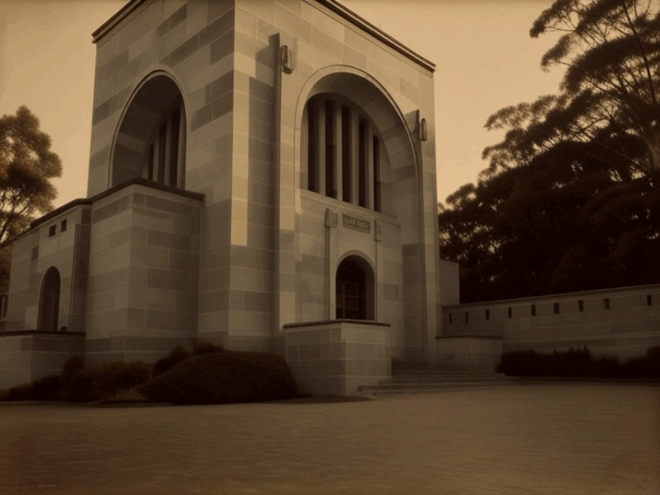
The Australian War Memorial (AWM) in Canberra stands as a cornerstone of national identity, dedicated to commemorating the sacrifices of Australians who served and died in wars, conflicts, and peacekeeping operations. Established in 1941, the AWM serves as both a memorial and a museum, preserving artefacts, records, and stories that reflect Australia’s military history. However, its increasing ties to weapons manufacturers and its emphasis on militaristic displays have sparked debates about its purpose and tone. These practices risk transforming the AWM into a platform that glorifies war and serves corporate interests, rather than a solemn space for quiet contemplation. This essay argues that the AWM should prioritise reverence, reflection, and human stories to honor the fallen, support veterans, and align with Australia’s values of peace and reconciliation. By exploring the ethical implications of its current practices, their impact on veterans, and the broader case for solemnity, this paper proposes reforms to ensure the AWM remains a place of dignity and remembrance.
The Purpose of the AWM: Commemoration, Not Celebration
War memorials exist to honor those who suffered or died in conflict, providing spaces for societies to reflect on loss, grapple with war’s consequences, and commit to peace. The AWM’s mission – to commemorate “the sacrifice of those Australians who have died in war” – underscores its role as a site of remembrance. Its Roll of Honour, inscribed with over 102,000 names and spaces like the Hall of Memory and the Tomb of the Unknown Australian Soldier embody this purpose, inviting visitors to contemplate the human cost of war. However, the AWM’s dual role as a museum introduces tensions that undermine this mission.
The museum component, with its displays of tanks, aircraft, and weaponry, often emphasises the technological and strategic aspects of war. While historically significant, these exhibits can evoke awe rather than introspection, presenting war as an exciting endeavour rather than a tragedy. For example, the Anzac Hall’s Lancaster bomber “G for George” draws attention for its scale, overshadowing quieter spaces that foster reflection. This focus risks glorifying war, particularly for younger visitors who may lack the context to understand its devastating impact.
Moreover, the AWM’s growing partnerships with weapons manufacturers – such as Boeing, Lockheed Martin, Thales, and BAE Systems – exacerbate these concerns. These companies, which profit from military hardware, sponsor exhibitions and events, raising questions about the memorial’s neutrality. By aligning with the military-industrial complex, the AWM risks becoming a platform for corporate interests, undermining its role as a sacred space. Instead, it should foster an atmosphere of solemn contemplation, where the futility and tragedy of war are central, ensuring that visitors engage with its human toll rather than its spectacle.
Ethical Implications of Current Practices
The AWM’s practices raise profound ethical concerns that challenge its integrity and mission. These issues – centered on corporate sponsorship, the glorification of war, and inclusivity – highlight the need for a shift toward solemnity.
Corporate Sponsorship and Moral Conflict
The AWM’s ties to weapons manufacturers create a moral contradiction. These companies profit from the production of tools used in the conflicts that the AWM commemorates, and their sponsorship of exhibitions or redevelopment projects risks legitimising their role in perpetuating war. For visitors, particularly those who have lost loved ones, the presence of corporate branding from arms companies can feel like a betrayal, turning a space of remembrance into a billboard for the arms industry. Ethically, the AWM must remain neutral, free from influences that conflict with its commemorative purpose.
Public 2018 protests against BAE System’s sponsorship, trust is also at stake. Controversies, such as these reflect widespread unease about these partnerships. By accepting funding from industries that thrive on conflict, the AWM risks eroding its credibility as a place of integrity. To address this, it should prohibit sponsorship from arms companies and seek funding from public or cultural sources, ensuring that its mission remains untainted by commercial interests.
Glorification of War
The AWM’s emphasis on military technology – through displays of tanks, aircraft, and weapons – can desensitise visitors to the realities of violence. These exhibits, designed to impress, risk presenting war as a heroic or innovative endeavour, particularly to younger audiences. For example, interactive displays that allow visitors to “experience” military equipment may be engaging, but can trivialise the destructive purpose of such tools. Ethically, the AWM has a duty to foster empathy for war’s victims, not admiration for its instruments.
This focus also marginalises human stories. The Roll of Honour and personal artefacts like letters and medals are powerful reminders of individual sacrifice, yet they are often overshadowed by militaristic displays. By prioritising spectacle over substance, the AWM risks reducing the fallen to footnotes in a narrative of technological prowess, failing to honour their full humanity.
Inclusivity and Diverse Perspectives
The AWM serves a diverse audience, including veterans, families, and communities affected by Australia’s military history. Its current practices, however, risk alienating certain groups. For Indigenous Australians, whose contributions to military service are underrepresented, the focus on mainstream narratives can feel exclusionary. Similarly, diaspora communities from countries like Afghanistan or Iraq may view the AWM’s militaristic displays or corporate ties as insensitive, given Australia’s role in those conflicts. Ethically, the AWM must ensure that all visitors feel respected, creating a space that acknowledges diverse experiences and the broader impacts of war, such as its effects on civilians and refugees.
Impact on Veterans: Emotional and Ethical Considerations
Veterans are among the AWM’s most significant stakeholders, relying on the memorial as a place to honour their service, mourn comrades, and find solace. However, its current practices can have a detrimental impact, exacerbating trauma, eroding trust, and marginalising diverse veteran experiences.
Emotional and Psychological Effects
The AWM’s militaristic displays can be deeply unsettling for veterans, many of whom live with PTSD, anxiety, or depression. Encounters with military equipment – such as a tank or aircraft associated with a traumatic event – can trigger painful memories, making the memorial feel hostile rather than healing. For example, a veteran of Afghanistan might find a display of a military vehicle distressing, disrupting their ability to reflect or mourn. The AWM’s crowded, high-energy exhibition halls further exacerbate this issue, overshadowing quieter spaces like the Hall of Memory that are better suited for contemplation.
These displays also risk trivialising veterans’ sacrifices. By focusing on technology, the AWM may fail to capture the personal and emotional dimensions of service – camaraderie, loss, or the challenges of reintegration. Veterans may wish to see exhibits that highlight their letters, medals, or stories, rather than polished machines. This disconnect can leave them feeling unrecognised, undermining the memorial’s role as a place of validation.
Ethical Concerns of Corporate Ties
The AWM’s partnerships with weapons manufacturers are particularly troubling for veterans. For many, the memorial is a sacred space to honour fallen comrades, and the involvement of companies that profit from war can feel like a betrayal. Veterans may perceive these partnerships as exploiting their service to promote corporate interests, leading to disillusionment or anger. This is especially true for veterans who are critical of the arms industry or who advocate for peace, as the AWM’s ties to these companies can create a moral conflict, deterring them from engaging with the memorial.
Trust is also a critical issue. When the AWM accepts funding from arms companies, veterans may question whether it prioritises corporate agendas over their needs. Public controversies, such as those surrounding BAE Systems, have amplified these concerns, with veterans’ groups among the critics. Ethically, the AWM must maintain veterans’ trust by ensuring that its practices align with their values and experiences.
Representation of Diverse Veteran Experiences
Veterans are a diverse group, encompassing different genders, cultural backgrounds, and roles. The AWM’s focus on combat and technology often fails to represent these varied experiences, marginalising certain veterans. Indigenous veterans, who faced discrimination despite their service, are underrepresented in exhibits, leaving them feeling excluded. Women veterans, who served as nurses, administrators, or combatants, are similarly overlooked, as the AWM’s masculinised narratives prioritise traditional images of warfare. Veterans of recent conflicts, such as Afghanistan and Iraq, may also find the memorial’s focus on earlier wars less relevant, particularly if they harbor complex feelings about those interventions. By neglecting these stories, the AWM risks alienating veterans who seek recognition of their unique contributions.
The AWM also fails to address veterans’ post-service challenges, such as PTSD, physical disabilities, or social isolation. Exhibits that acknowledge these realities could foster empathy and validation, but the current emphasis on wartime achievements leaves little room for such narratives. Ethically, the AWM must provide a platform for veterans to see their full stories represented, ensuring that they feel valued and included.
The Case for Solemn Contemplation
To address these ethical and emotional concerns, the AWM must prioritise solemn contemplation over glorification and corporate influence. This approach aligns with its commemorative mission, supports veterans, and reflects Australia’s values of peace and reconciliation.
Honouring the Human Cost
Solemn contemplation centres the human cost of war, encouraging visitors to engage with the stories behind the Roll of Honour – each name representing a life lost, a family shattered, or a community diminished. Exhibits that highlight personal artefacts, letters, and oral histories can foster empathy and reflection, ensuring that the AWM honours the fallen with dignity. By contrast, militaristic displays risk reducing war to a series of mechanical achievements, distracting from its profound tragedy. A rebalanced focus – toward human stories and away from technology – would create a more reverent atmosphere.
Supporting Veterans’ Needs
For veterans, solemn contemplation offers a healing environment. Quiet spaces like the Hall of Memory or the Commemorative Courtyard provide solace for reflection and mourning, but these areas must be expanded and prioritised over noisy exhibition halls. Exhibits that address veterans’ diverse experiences – Indigenous service, women’s contributions, or post-service challenges – can foster inclusion and validation. By creating a tranquil, human-centered environment, the AWM can better support veterans’ emotional and psychological well-being.
Promoting Peace and Reconciliation
Australia’s national identity increasingly emphasises peace, multiculturalism, and reconciliation. The AWM can reflect these values by fostering critical reflection on war’s causes and consequences, encouraging visitors to consider how Australia can contribute to global peace-building. Exhibits on peacekeeping operations or the experiences of war-affected migrants can highlight these themes, while a shift away from militaristic displays can challenge romanticised notions of war. This approach positions the AWM as a forward-thinking institution that honours the past while inspiring a peaceful future.
Ensuring Ethical Integrity
By ending partnerships with weapons manufacturers, the AWM can restore its neutrality and public trust. Funding from public or cultural sources would align with its commemorative mission, ensuring that it remains free from corporate influence. This shift is particularly crucial for veterans, who deserve a memorial untainted by industries that profit from war. Ethically, the AWM must prioritise integrity over financial expediency, creating a space that respects all visitors.
Practical Recommendations for Reform
To transform the AWM into a place of solemn contemplation, the following reforms are proposed:
1. Prohibit Corporate Sponsorship from Arms Companies: Ban funding or partnerships with weapons manufacturers, seeking alternative support from public, cultural, or community sources to maintain neutrality and trust.
2. Reorient Exhibits Toward Human Stories: Reduce the prominence of military hardware and prioritise personal narratives – letters, diaries, oral histories, and artefacts – to foster empathy and reflection. Create dedicated galleries for Indigenous veterans, women veterans, and those from recent conflicts.
3. Expand Contemplative Spaces: Increase the availability of quiet areas like the Hall of Memory, with design elements such as subdued lighting, seating, and audio testimonies to create a healing environment for veterans and visitors.
4. Strengthen Educational Programs: Develop programs that emphasise the human cost of war and encourage critical thinking about conflict, particularly for school groups and young visitors. Include narratives of veterans’ post-service challenges to foster empathy.
5. Engage Diverse Communities: Consult with veterans’ organisations, Indigenous groups, and multicultural communities to ensure that the AWM’s narratives are inclusive and sensitive to diverse experiences.
6. Address Veterans’ Needs: Create exhibits and programs that acknowledge veterans’ mental health, reintegration, and diverse contributions, ensuring that they feel validated and supported.
Conclusion
The Australian War Memorial is entrusted with the sacred responsibility of honouring those who sacrificed their lives in service. Its current practices – partnerships with weapons manufacturers and an emphasis on militaristic displays – risk undermining this mission, glorifying war, eroding trust, and alienating veterans. These issues raise profound ethical concerns, from the moral conflict of corporate ties to the emotional toll on veterans and the marginalisation of diverse perspectives. By prioritising solemn contemplation, the AWM can realign with its commemorative purpose, creating a space that fosters reflection, supports veterans, and promotes peace. Through practical reforms – ending arms sponsorship, centering human stories, and expanding contemplative spaces – the AWM can ensure that it honours the fallen with dignity, respects its diverse audiences, and inspires a commitment to a more peaceful future. In doing so, it will remain a beacon of remembrance and reconciliation for generations to come.



